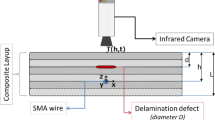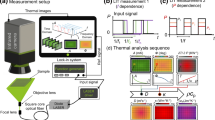Abstract
This text analyzes the effects of calibration settings on a self-referencing processing routine, when applied to inspecting a set of Carbon Fiber composite structures via pulsed thermographic apparatus. The Self-referencing algorithm operates on acquired thermograms by tracking each pixel location contrast-temporal cooling curve, to expose any potential deviation and acquire quantitative assessment of the host material subsurface condition. The calibration factors in this study include; the kernel size that represents the sound (or defect-free) or reference, temperature-time history, the threshold in each center pixel signal relative to its surrounding (average of the kernel pixel population). The study quantifies the effect of each factor using a pulsed thermographic test campaign; first applied to a set of artificially designed samples; in addition to actual blind samples. The controlled coupons are 3D printed out of plastics; while the defects are embedded (via 3D printing) to represent different and controlled shapes and configurations. The 3D printed samples are used to help represent different fill-rates to imitate honeycomb structures, and to embed defects of finite thickness. The study findings highlights the effect of each of the calibration settings and demonstrate tangible improvement in the processed frames.















Similar content being viewed by others
References
Rajic, N.: Principal component thermography for flaw contrast enhancement and flaw depth characterisation in composite structures. Compos. Struct. 58(4), 521–528 (2002)
Waugh, R.C.: The Physics and Implementation of Thermography. Springer (2016)
Zhou, Y., Mayyas, A., Omar, M.A.: Principal component analysis-based image fusion routine with application to automotive stamping split detection. Res. Nondestruct. Eval. 22(2), 76–91 (2011)
Shepard, S., Ducar, R.J.: Quantitative infrared defect detection in composite aerospace structures. In: SAMPE 2000: 45 th International SAMPE Symposium and Exhibition (2000)
Omar, M.A., Zhou, Y.: A quantitative review of three flash thermography processing routines. Infrared Phys. Technol. 51(4), 300–306 (2008)
Maldague, X., Marinetti, S.: Pulse phase infrared thermography. J. Appl. Phys. 79(5), 2694–2698 (1996)
Omar, M., Parvataneni, R., Zhou, Y.: A combined approach of self-referencing and Principle Component Thermography for transient, steady, and selective heating scenarios. Infrared Phys. Technol. 53(5), 358–362 (2010)
Omar, M., Hassan, M., Saito, K., Alloo, R.: IR self-referencing thermography for detection of in-depth defects. Infrared Phys. Technol. 46(4), 283–289 (2005)
Omar, M., Hassan, M., Donohue, K., Saito, K., Alloo, R.: Infrared thermography for inspecting the adhesion integrity of plastic welded joints. NDT&E Int. 39(1), 1–7 (2006)
Omar, M.A., Zhou, Y., Parvataneni, R., Planting, E.: Calibrated pulse-thermography procedure for inspecting HDPE. Adv. Mater. Sci. Eng. 2008 (2009)
Pickering, S., Almond, D.: Matched excitation energy comparison of the pulse and lock-in thermography NDE techniques. NDT&E Int. 41(7), 501–509 (2008)
Fernandes, H., Ibarra-Castanedo, C., Zhang, H., Maldague, X.: Thermographic non-destructive evaluation of carbon fiber-reinforced polymer plates after tensile testing. J. Nondestruct. Test. Eval. 34(4), 1–10 (2015)
Passilly, F., Balageas, D.: A TSR-based quantitative processing procedure to synthesize thermal D-scans of real-life damage in composite structures. J. Nondestruct. Eval. 34(4), 1–15 (2015)
Acknowledgments
This work has been sponsored by a Mubadala Aerospace and Engineering Services research grant. The Strata Engineering & Production team are further acknowledged for their technical support.
Author information
Authors and Affiliations
Corresponding author
Rights and permissions
About this article
Cite this article
Omar, M.A., Said, Z., Raisi, A.A. et al. The Calibration and Sensitivity Aspects of a Self-Referencing Routine When Applied to Composites Inspection: Using a Pulsed Thermographic Setup. J Nondestruct Eval 35, 51 (2016). https://doi.org/10.1007/s10921-016-0367-3
Received:
Accepted:
Published:
DOI: https://doi.org/10.1007/s10921-016-0367-3




